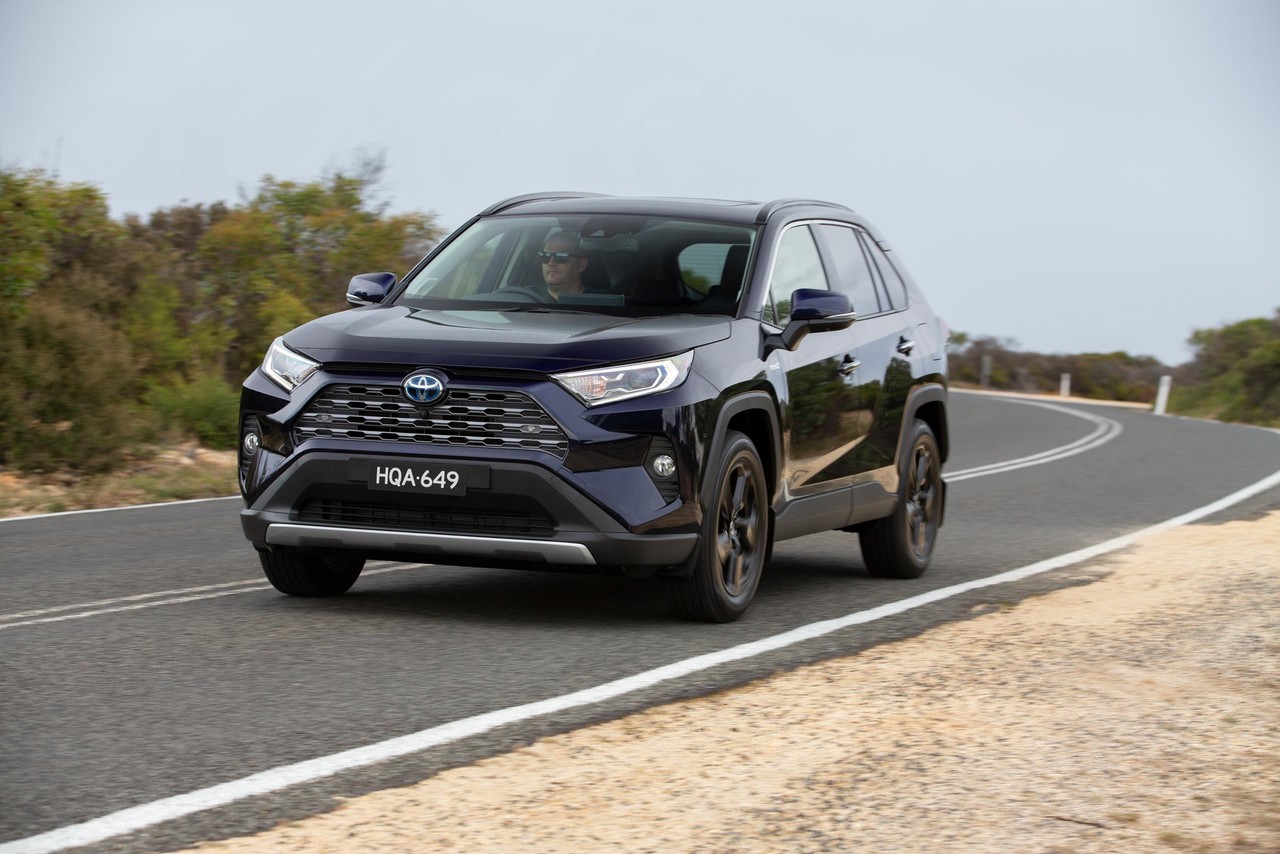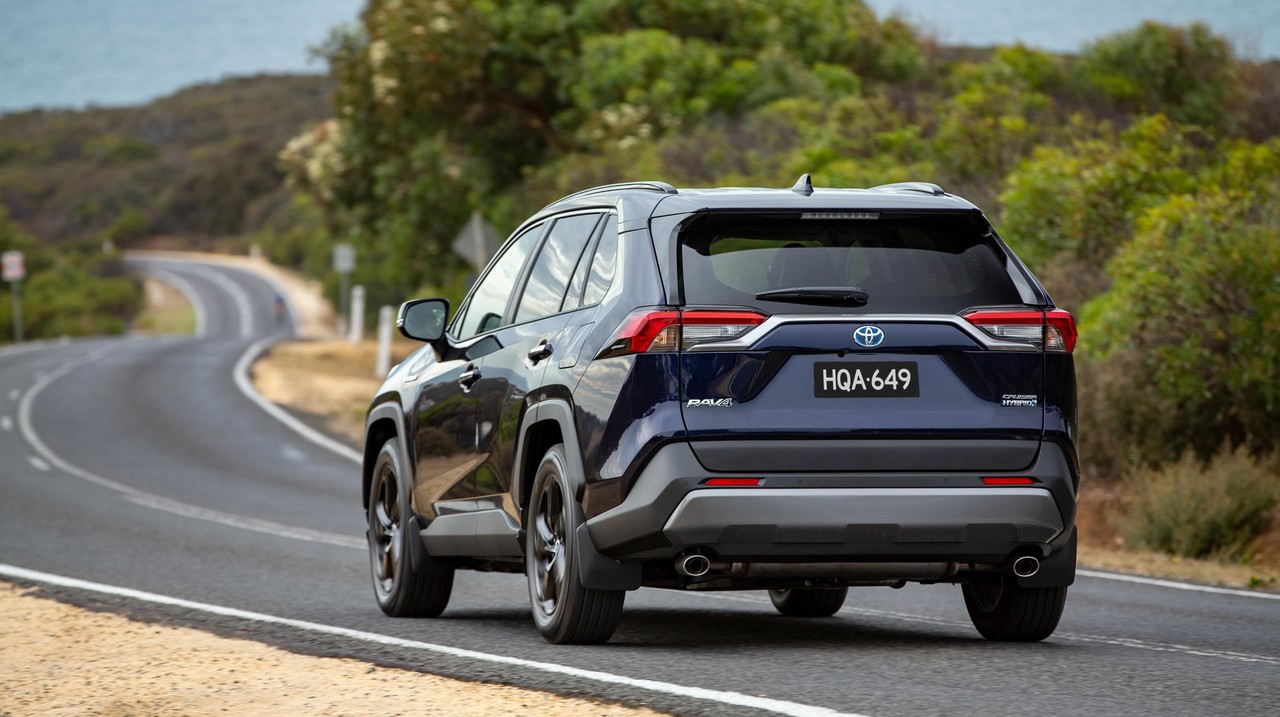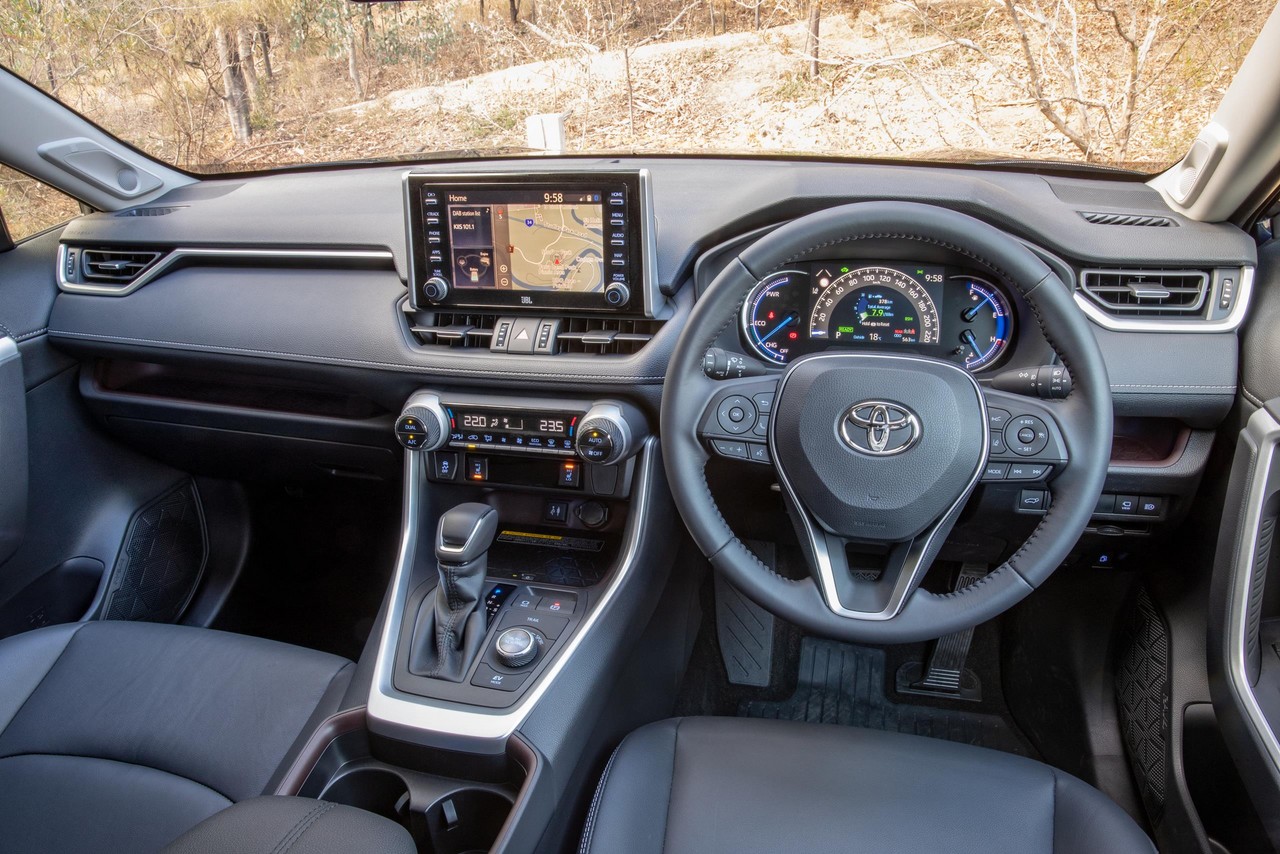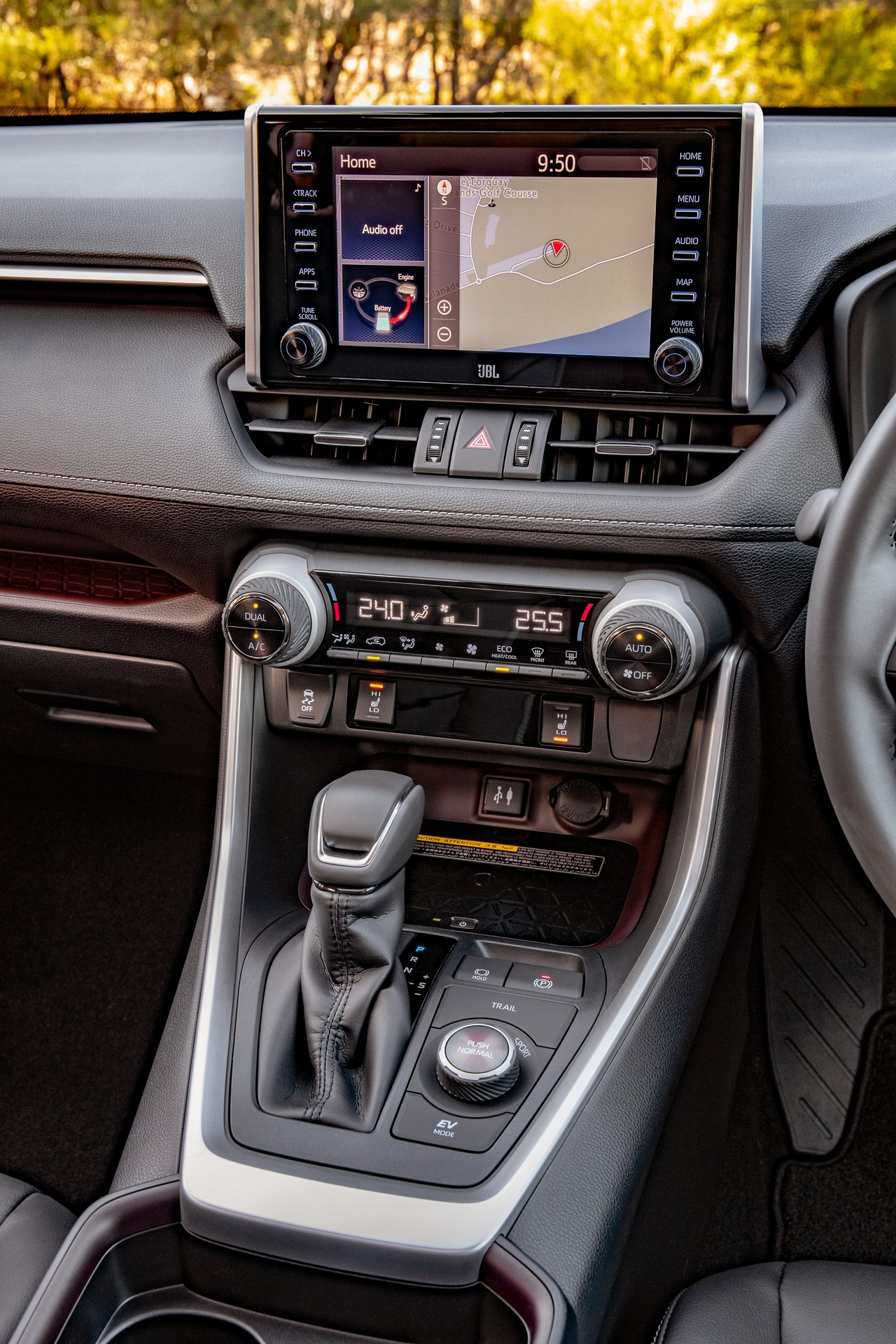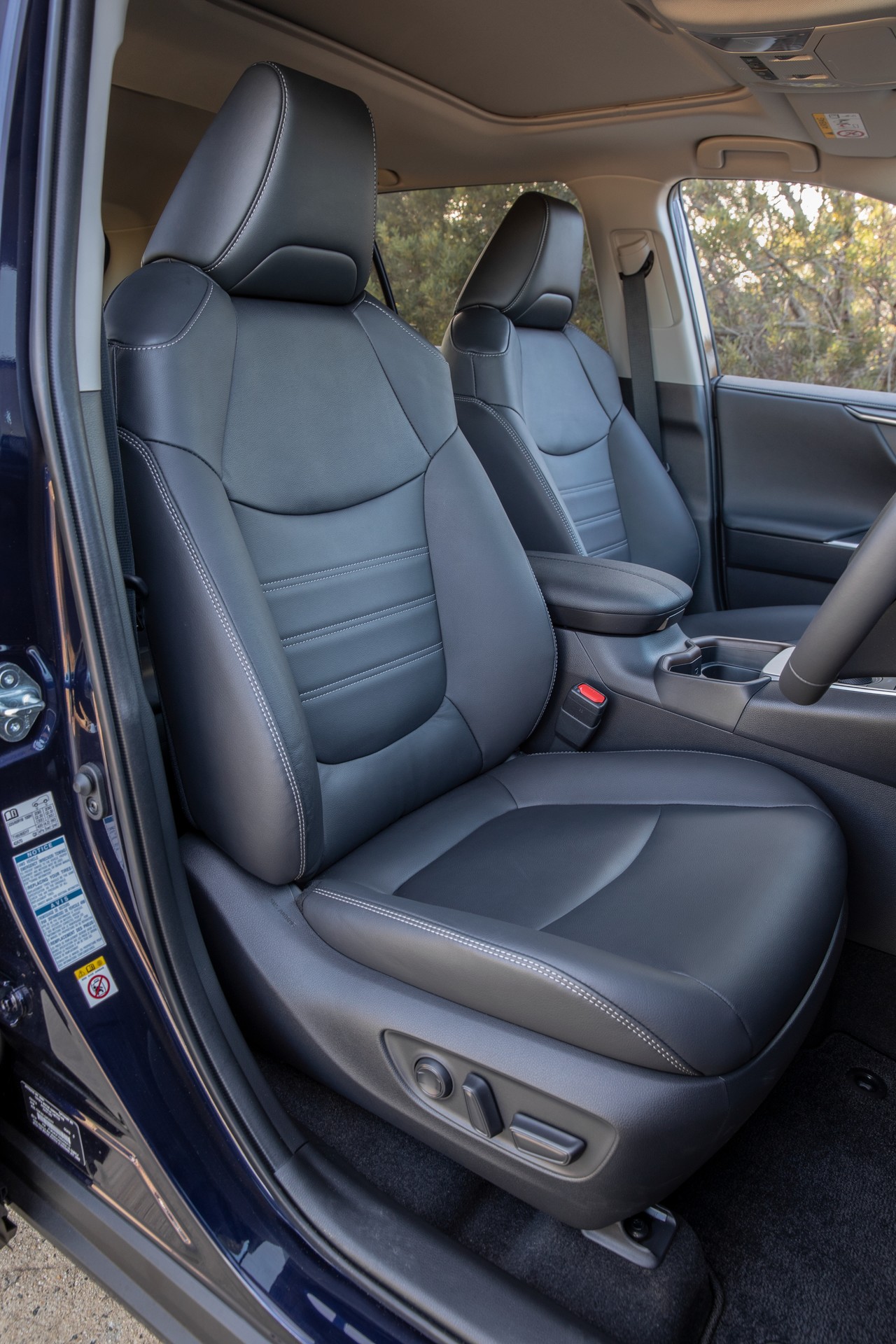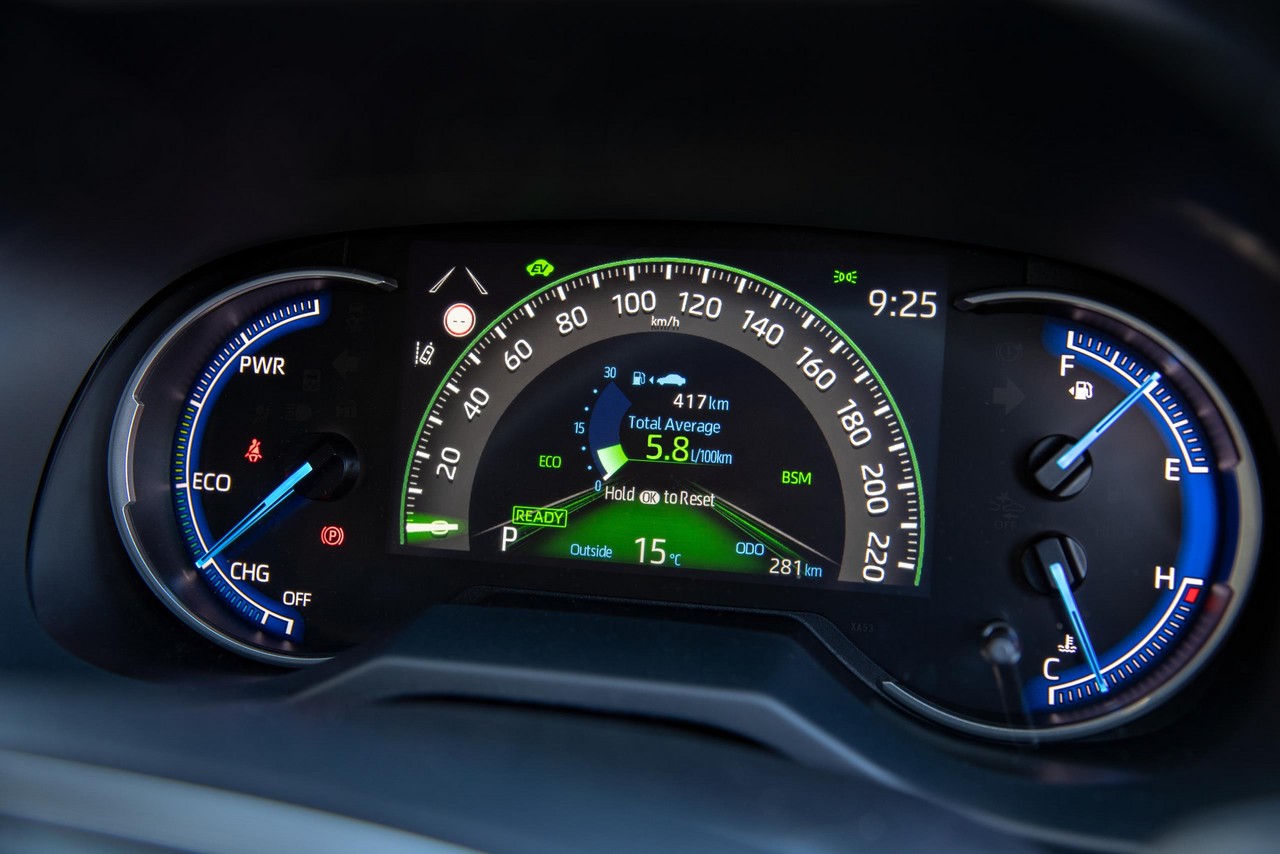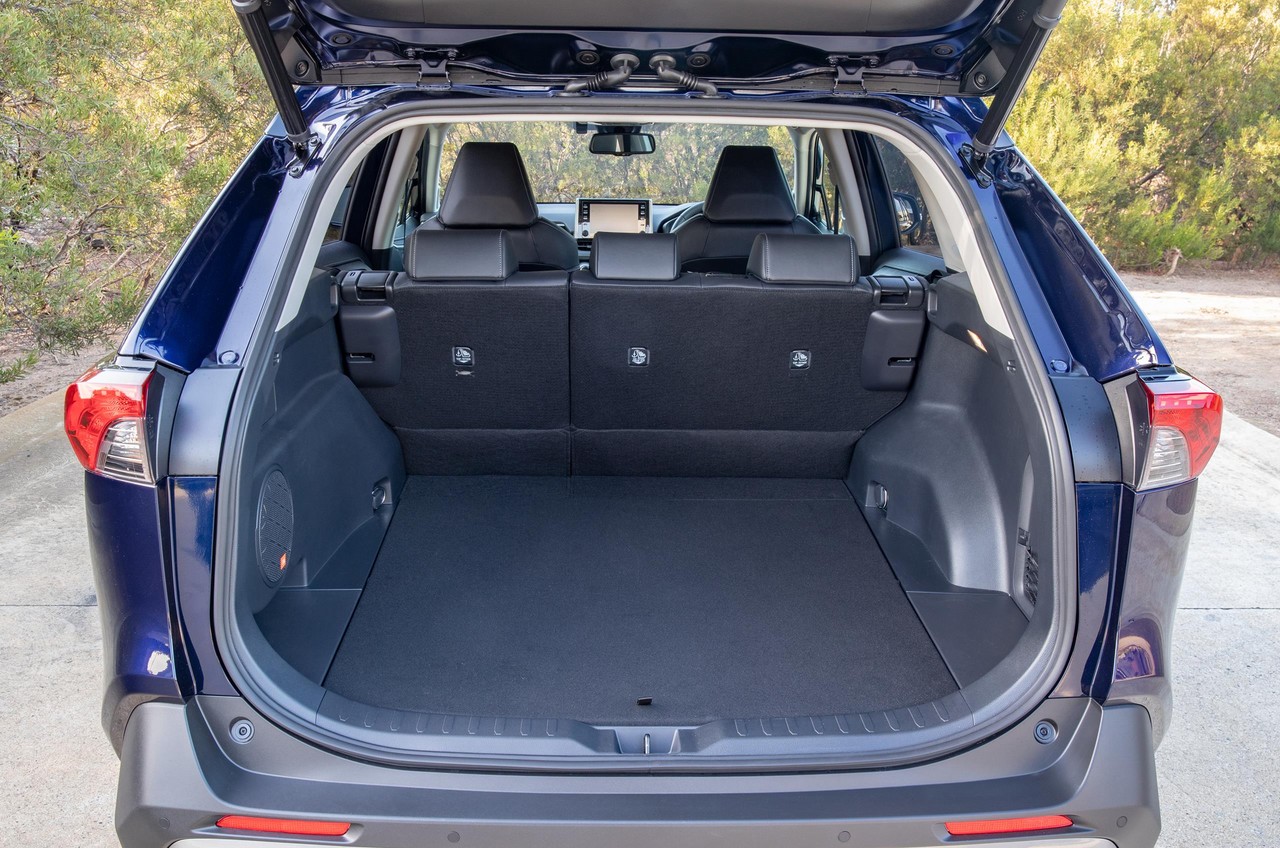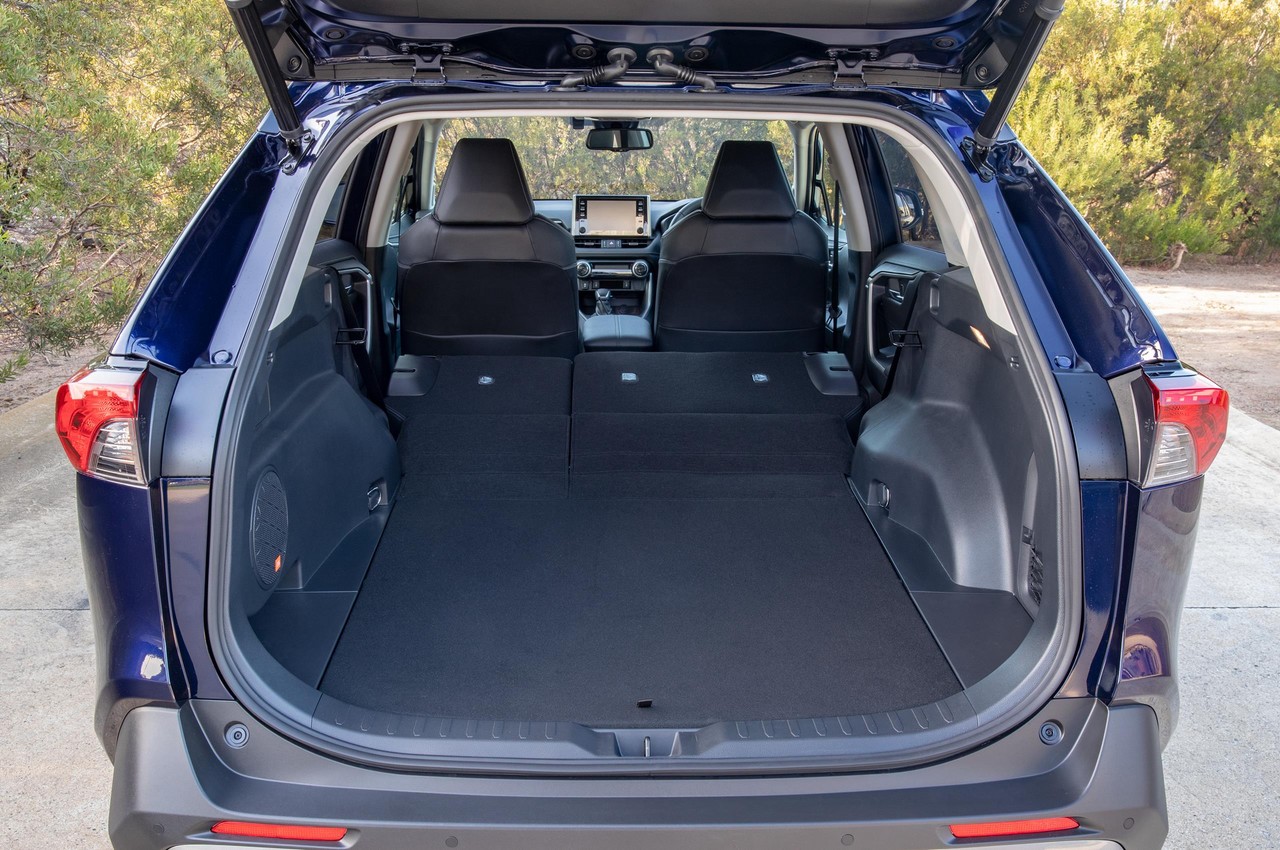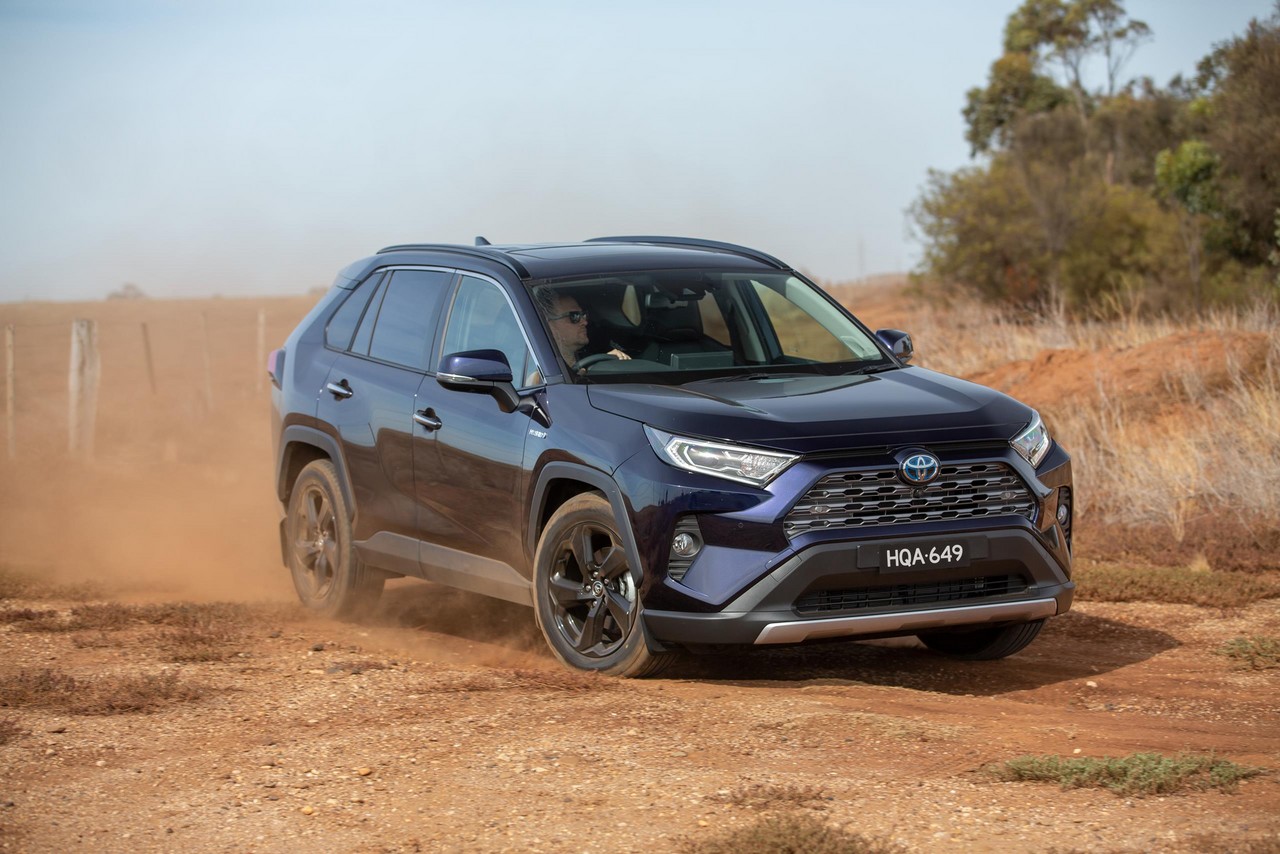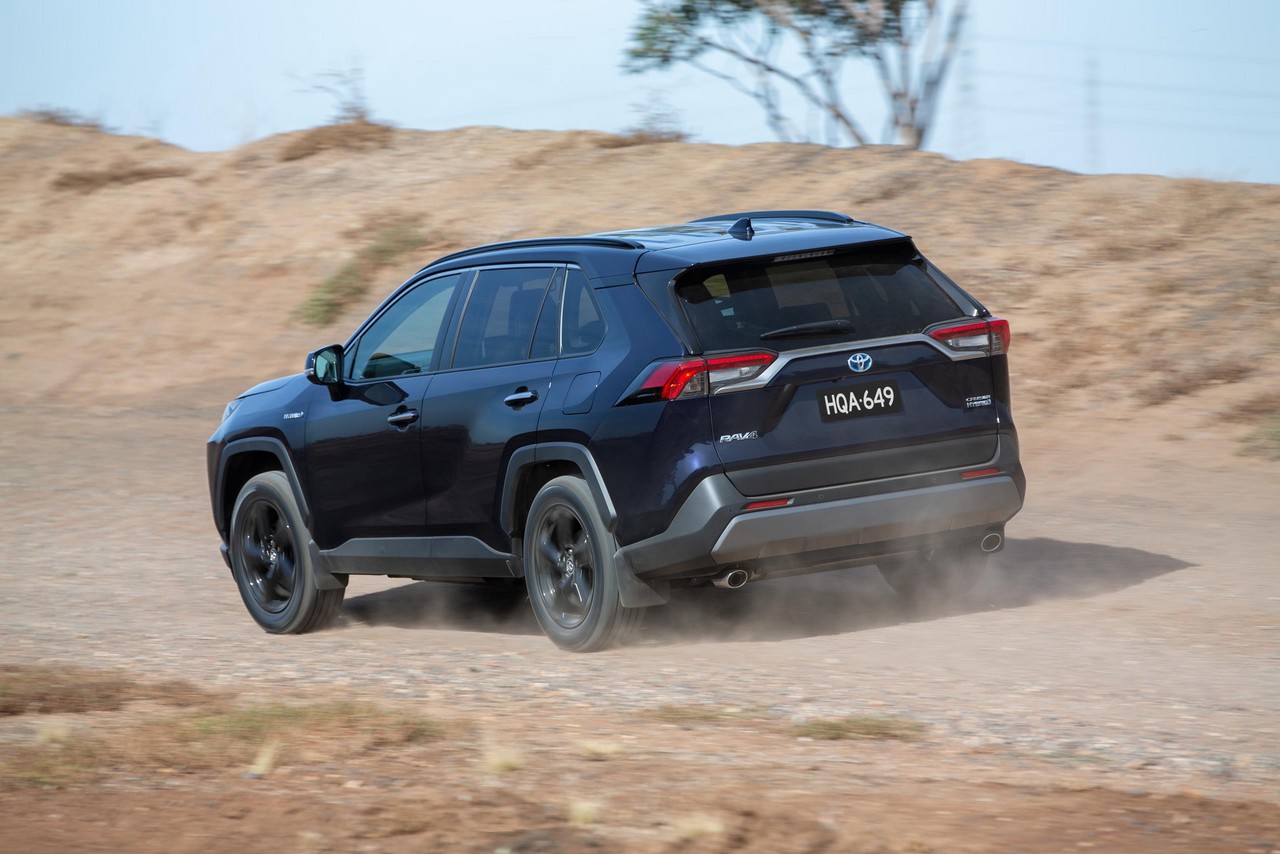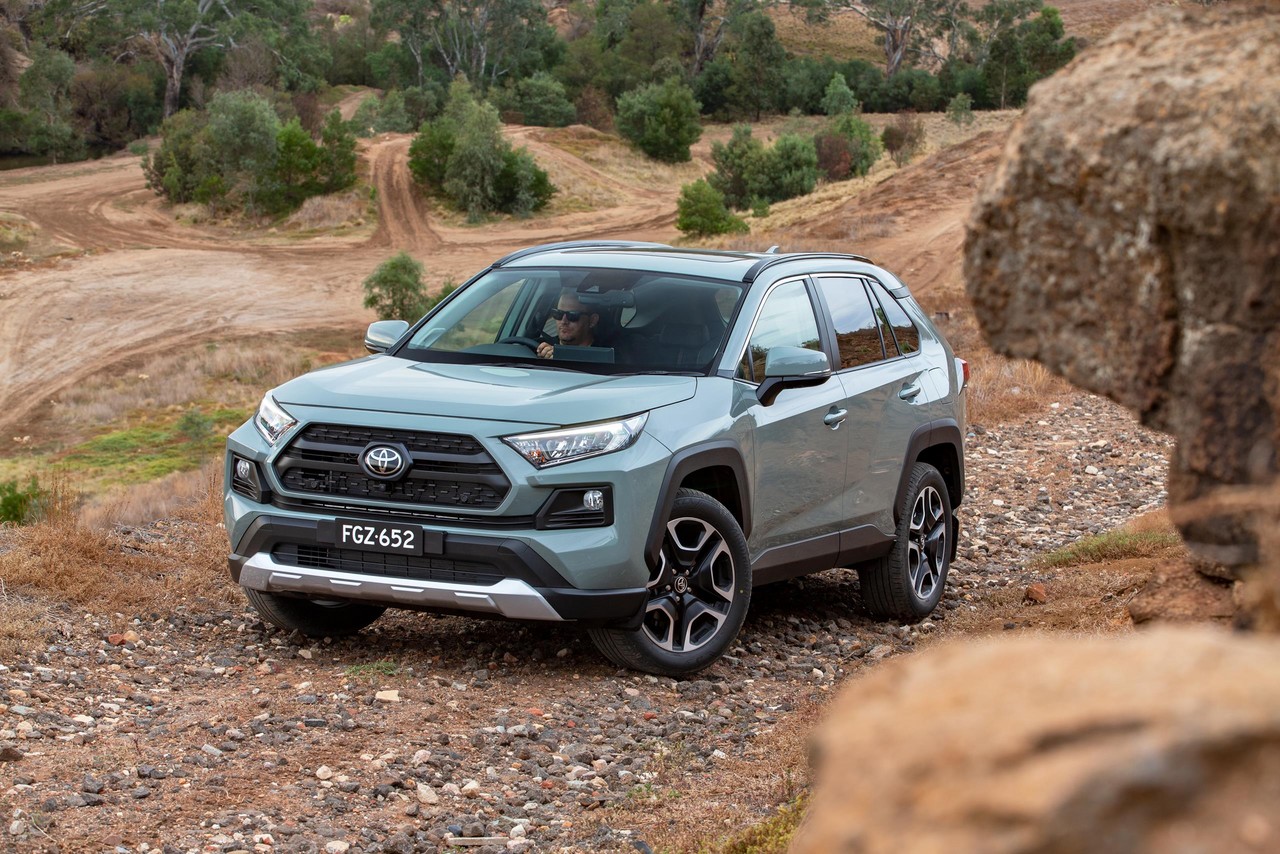
- Efficient petrol and hybrid powertrains
- Active safety technologies fitted as standard
- Spacious interior and improved materials
- Good ride/handling balance…
- … though sharp bumps could be better absorbed
- Steering lacks feel and feedback
- Engine noise when under load
- Underwhelming performance with 2.0-litre engine
- For RAV4 2.5i, eight-speed auto is indecisive when down-shifting
- Apple CarPlay and Android Auto not available until Q4 2019
Overview
Released in Australia in May 2019, the Toyota XA50 RAV4 was a mid-size SUV. Manufactured in Japan, the Toyota XA50 RAV4 was offered with three powertrains –
- For the front-wheel drive RAV4, a 2.0-litre four-cylinder petrol engine was mated to a six-speed manual or continuously variable transmission (CVT);
- For the all-wheel drive RAV4, a 2.5-litre four-cylinder petrol engine was mated to an eight-speed automatic transmission; and,
- For the RAV4 Hybrid, a 2.5-litre four-cylinder petrol engine and electric motor were mated to a CVT. The RAV4 Hybrid was offered with front- and all-wheel drive powertrains.
XA50 RAV4 and RAV4 Hybrid: A25A-FKS engine
The die-cast aluminium alloy cylinder block A25A-FKS engine had 87.5 mm bores and a 103.4 mm stroke for a capacity of 2487 cc. Other attributes of the A25A-FKS engine included its aluminium alloy cylinder head, double overhead camshafts (chain-driven), roller rocker arms and four valves per cylinder. For standard and hybrid applications, the A25A-FKS engine had compression ratios of 13.0:1 and 14.0:1, respectively. Other features of the A25A-FKS engine included:
- Toyota’s ‘D-4S’ fuel injection system which could switch between direct injection (via six-hole nozzle injectors) and traditional port injection. Under low and medium load conditions, port injection was used since it provided greater air/fuel mixing;
- A 41 degree angle between the intake and exhaust valves;
- For the intake camshaft, Toyota’s ‘VVT-iE’ camshaft timing used an electric motor to vary the VVT-i controller for camshaft advance or retard (thereby varying intake valve timing);
- For the exhaust camshaft, the conventional VVT-i system had an oil control valve (OCV) that controlled a spool valve so that hydraulic pressure could be applied to the advance or retard side of the VVT-i controller. Rotation of the VVT-i controller vane sub-assembly (relative to the timing chain sprocket) then varied exhaust valve timing. The exhaust camshaft also had a mid-position lock mechanism; and,
- In a world first, a trochoid-type continuous variable capacity oil pump.
AustralianCar.Reviews understands that the A25A-FKS engine had two counter-rotating balance shafts. According to Toyota, the A25A-FKS engine had a thermal efficiency of 40 per cent for its petrol-powered vehicles and 41 per cent in hybrid vehicles.
For the Toyota RAV4 Hybrid, the A25A-FKS engine was combined with two electric motor generators (MG1 and MG2), though only MG2 was used to power the wheels. For the RAV4 Hybrid, the nickel-metal hydride (Ni-MH) battery had newly developed ‘Hyper-Prime Nickel’ technology to improve performance while reducing size and weight. The battery has a nominal voltage of 244.8 V (204 cells, 1.2V/cells), a capacity of 6.5 ampere hours and a system voltage of 650 volts.
M20A-FKS engine
The 1987 cc M20A-FKS engine had an aluminium alloy cylinder block with 80.5 mm bores and a 97.6 mm stroke. Beyond this, the aluminium alloy cylinder head had chain-driven double overhead camshafts (DOHC) and four valves per cylinder –
- For the intake camshaft, Toyota’s ‘VVT-iE’ camshaft timing used an electric motor to vary the valve timing controller for camshaft advance or retard; and,
- The exhaust camshaft had a conventional hydraulic VVT-i system in which the camshaft timing oil control valve (OCV) controlled a spool valve that enabled hydraulic pressure to be applied to the advance or retard side of the VVT-i controller. In response, rotation of the VVT-i controller vane sub-assembly (relative to the timing chain sprocket) varied valve timing. The exhaust camshaft also had a mid-position lock mechanism.
The M20A-FKS engine had Toyota’s ‘D-4S’ fuel injection system which enabled it to use port injection or direct injection depending on running conditions. Furthermore, the M20A-FKS engine had a compression ratio of 13.0:1.
| Engine | Trans. | Peak power | Peak torque | ||
|---|---|---|---|---|---|
| RAV4 FWD | GX | 1986 cc M20A-FKS petrol I4 | 6sp man. (EG62) |
127 kW at 6600 rpm | 203 Nm at 4400-4900 rpm |
| GX, GXL, Cruiser |
1986 cc M20A-FKS petrol I4 | CVT (K120) |
127 kW at 6600 rpm | 203 Nm at 4400-4900 rpm | |
| RAV4 AWD | Edge | 2487 cc A25A-FKS petrol I4 | 8sp auto | 152 kW at 6600 rpm | 243 Nm at 4000-5000 rpm |
| RAV4 Hybrid FWD | GX, GXL, Cruiser |
2487 cc A25A-FKS petrol I4 | CVT | 131 kW at 5700 rpm | 221 Nm at 3600 rpm |
| MG1 | 88 kW at 4500 rpm | 202 Nm at 0-1500 rpm | |||
| Combined | 160 kW | N/A | |||
| RAV4 Hybrid AWD | GX, GXL, Cruiser |
2487 cc A25A-FKS petrol I4 | CVT | 131 kW at 5700 rpm | 221 Nm at 3600 rpm |
| MG1 | 88 kW at 4500 rpm | 202 Nm at 0-1500 rpm | |||
| MG2 | 40 kW | 121 Nm | |||
| Combined | 163 kW | N/A | |||
RAV4 Petrol: all-wheel drive system
For petrol-only powered models, the Toyota XA50 RAV4 had an on-demand all-wheel drive system. In normal conditions, the engine’s torque was sent to the front wheels; if there was a loss of traction or such a loss was anticipated, however, up to 50 per cent of the engine’s torque could be directed to the rear wheels. The all-wheel drive system also had:
- A rear driveline disconnect function which used ratchet-type dog clutches on both the front and rear wheel shafts. By disconnecting the rear axle when rear-wheel drive was not required, energy losses and rotational vibrations were reduced; and,
- Independent couplings on the rear axle output shafts that could vary the torque distribution – this capability could be used for torque vectoring which generated yaw to reduce understeer when cornering.
RAV4 Hybrid: all-wheel drive system
For the Toyota XA50 RAV4 Hybrid, the front wheels were driven by the petrol engine, the MG1 electric motor and the MG2 electric motor. The rear wheels, however, were driven by an additional ‘Motor Generator – Rear’ (MGR). For the Hybrid AWD system, the front:rear torque split can be varied from 100:0 to up to 20:80, depending on driving conditions. Furthermore, maximum torque to the rear wheels is 1300 Nm.
The front and rear axles of the Toyota RAV4 Hybrid were fitted with an ‘automatic limited-slip differential’ (auto-LSD). The auto-LSD could be activated by a drive mode selector on the centre console and, if a driven wheel lost contact with the ground on uneven terrain, that free rotating wheel was braked so that torque was directed to the wheel with traction.
Body and dimensions
The Toyota XA50 RAV4 was underpinned by the ‘Toyota New Global Architecture’ (TNGA) which was shared with the Toyota XV70 Camry . According to Toyota, the chassis of the XA50 RAV4 achieved a 57 per cent increase in torsional rigidity relative to the XA40 RAV4.
Compared to the Toyota XA40 RAV4 , the XA50 RAV4 was 30 mm longer (at 4600 mm), 10 mm wider (1855 mm), 15 mm lower (1700 mm) and had a 30 mm longer wheelbase (2690 mm). Luggage capacity was 542 litres, though this increased to 580 litres when the cargo floor was lowered. Furthermore, kerb weights for the Toyota XA50 RAV4 ranged from 1515 kg to 1745 kg.
Suspension and steering
The Toyota XA50 RAV4 had MacPherson strut front suspension and independent, multi-link rear suspension. Furthermore, the XA50 RAV4 had rack-and-pinion steering with electric power assistance; its turning circle was 11.0 metres (kerb to kerb).
Safety equipment
Standard safety equipment for the Toyota XA50 RAV4 is understood to include dual front airbags, a driver’s knee airbag, front seat-mounted side airbags, full-length curtain airbags (i.e. for front and rear occupants), ABS, electronic brake force distribution, brake assist, electronic stability control, traction control and front seatbelts with pre-tensioners and load limiters.
As standard, the Toyota XA50 RAV4 was equipped with ‘Toyota Safety Sense 2.0’ which included the following active safety technologies –
- Pre-Collision Safety System (PCS) with pedestrian and daylight cyclist detection: active at speeds above 10 km/h, used a windscreen-mounted monocular camera sensor and millimetre-wave radar to detect a preceding vehicle, pedestrian or cyclist and alert the driver via audible and visual warnings. In its second stage, PCS prepared the braking system so that additional braking force was provided when the brake pedal is depressed. If a collision was imminent, Automatic Emergency Braking (AEB) would be initiated to reduce vehicle speed and the severity of the collision;
- Active Cruise Control: using the same millimetre-wave radar as PCS, ACC could maintain a safe distance from the vehicle ahead when cruise control was active – this included applying the brakes to bring the vehicle to rest if necessary and accelerating back to the pre-selected cruising speed when safe to do so. For models with manual transmissions, however, ACC only operated at speeds above 40 km/h;
- Lane Trace Assist with steering assist and lane centring (models with auto and CVT only): Lane Trace Assist operated when Active Cruise Control was engaged and used the forward-facing camera to detect lane markings. Lane Trace Assist would then provide steering assistance to keep the vehicle in the centre of its lane, even on curved roads. Where lane markings were not visible, Lane Trace Assist used the position of the vehicle ahead so that the E210 Corolla would follow its path;
- Lane Departure Alert (LDA) with steering assist: used the windscreen-mounted camera to monitor the vehicle’s position relative to lane markings on the road surface. If the vehicle was about to depart from its lane without the turn indicator having been applied, an audible tone would alert the driver and a warning would appear in the multi-information display. If the vehicle continued to move outside its lane, light steering force would be applied to encourage the driver to move back into the lane. LDA also included a sway warning function that would prompt the driver to take a break if the system detected that the vehicle was drifting within its lane due to driver inattention;
- Automatic High Beam: operating at speeds above 30 km/h, Automatic High Beam would automatically switch between low and high beam lighting according to ambient light conditions. As such, Automatic High Beam used the windscreen-mounted camera to detect the headlights of oncoming vehicles or traffic ahead and, if detected, would automatically switch to low beam to avoid dazzling other road users; and,
- Road Sign Assist (RSA): the windscreen-mounted camera could recognise speed limit signs so that the speed limit would be displayed on the multi-information display (MID) in the instrument cluster.
As standard, the Toyota XA50 RAV4 was also fitted with:
- Blind Spot Monitor: used radar sensors mounted on the rear corners to detect vehicles in adjacent lanes as they moved into the driver’s blind spot. If detected, the driver would be alerted to their presence by the illumination of LED warning indicators in the door mirror on the side of the Toyota RAV4 where there was another vehicle, and the LEDs would remain illuminated while there was another vehicle in the driver’s blind spot. If the driver operated the indicators to move into the lane where there was another vehicle in the driver’s blind spot, the LEDs would flash rapidly; and,
- Rear Cross Traffic Alert: using the same radar sensors as the Blind Spot Monitor, Rear Cross Traffic Alert could detect traffic approaching from either side of the Toyota RAV4 as it reversed out of a parking space. Similarly, LEDs in the door mirror would illuminate to warn the driver.
Euro NCAP testing: 2019 Toyota XA50 RAV4
In Euro NCAP testing , the 2019 Toyota RAV4 received a five star safety rating which included a 93 per cent adult occupant protection rating and an 87 per cent child occupant protection rating. In the frontal offset test, protection of the driver’s head, thighs and feet were rated as good, though chest and lower leg protection was rated as adequate (i.e. a slight risk of serious injury). In the side impact and pole tests, chest and trunk protection was rated as good, though head protection was rated as adequate.
Brakes
The Toyota XA50 RAV4 had 305 mm by 28 mm ventilated front brake discs and 281 mm by 12 mm solid rear discs.
Features: Toyota RAV4 GX
The standard infotainment system for the Toyota XA50 RAV4 consisted of a six speaker audio system with digital radio tuner (DAB+), an eight-inch colour touchscreen, satellite navigation with SUNA live traffic updates, Bluetooth mobile phone connectivity, voice recognition, a 3.5 mm auxiliary and USB input. From the fourth quarter of 2019, the infotainment system also included Apple CarPlay and Android Auto smartphone integration.
Beyond this, standard features for the Toyota RAV4 GX included 17-inch alloy wheels, LED headlamps, front fog lamps, daytime LED running lights, dusk-sensing headlamps, rain-sensing wipers, reversing camera with fixed lines, front and rear parking sensors, 60/40 split fold rear seats, remote central locking, power adjustable door mirrors with heating and retracting functions, power windows, tilt and telescopic steering column adjustment, a 4.2-inch instrument cluster display, trip computer and immobiliser. The RAV4 GX Hybrid was also equipped with push-button start.
Features: Toyota RAV4 GXL
Compared to the RAV4 GX, the RAV4 GXL was further equipped with 18-inch silver finished alloy wheels, ‘premium’ embossed fabric seats, dual-zone climate control air conditioning, reversing camera with dynamic guideliens, ‘premium’ steering wheel and gear lever, proximity key, an electrochromatic rear view mirror, four additional USB ports, wireless mobile phone charger (Qi standard), rear privacy glass and roof rails.
Unlike the RAV4 GX, the RAV4 GXL, Cruiser and Edge were also fitted with front mudflaps.
Features: Toyota RAV4 Cruiser
Relative to the RAV4 GXL, the RAV4 Cruiser added a nine speaker JBL audio system, leather accented seats, ten-way power adjustable and heated front seats, driver’s seat memory settings, panoramic view monitor, moonroof (tilt and slide operation), power-operated tailgate, ambient lighting and a seven-inch instrument cluster display.
Visually, the RAV4 Cruiser could be identified by its ‘premium’ bumper, silver grille, and chrome door handles. While the RAV4 Cruiser had 19-inch silver alloy wheels, the RAV4 Hybrid Cruiser had 18-inch gloss black alloy wheels.
Features: Toyota RAV4 Edge
In terms of features, the Toyota RAV4 Edge was distinguished by its ‘SofTex’ seats, ventilated front seats, selectable all-wheel drive modes (‘mud and sand’, ‘rock and dirt’ and snow) and Downhill Assist Control; driver seat memory settings, however, were omitted. Visually, the RAV4 Edge was differentiated by its 19-inch machined face alloy wheels, unique front bumper and grille, skid plate, fog lamp surrounds and wheel arch mouldings.
Brochure and Specifications

